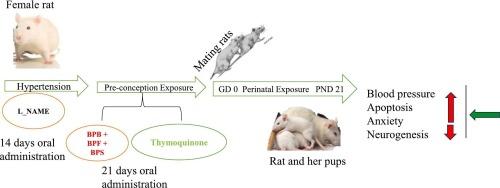Thymoquinone inhibits Neuroinflammatory mediators and vasoconstriction injury via NF-κB dependent NeuN/GFAP/Ki-67 in hypertensive Dams and F1 male pups on exposure to a mixture of Bisphenol-A analogues
IF 3.3
3区 医学
Q2 PHARMACOLOGY & PHARMACY
引用次数: 0
Abstract
Bisphenol-A (BPA) analogues seem inevitable components of numerous domestic products, but these have been identified as agents of teratogenic disorders. This study, therefore, investigated the effect of thymoquinone (TMQ) on the striatum of hypertensive female rats and their F1 male offsprings, on exposure to a mixture of Bisphenol-B, Bisphenol-F and Bisphenol-S (MBFS). Female rats were divided into normotensive and hypertensive groups; and both were treated with MBFS only, MBFS + TMQ, and TMQ only. Exposure to MBFS and co-treatment with TMQ lasted at least 63 days. Neurobehavioural assessments were conducted using Open Field (OF). A spectrophotometer was used for cholinergic, dopaminergic and adenosinergic enzyme assays; Real-Time PCR for gene expression; and immunohistochemistry for protein quantification; while H&E, cresyl fast violent, and congo red stains were used for histological assessments. From the results, maternal exposure to MBFS mediated striatal dysfunction via p53 and NF-kB upregulation; decreased BCl-2, Ki-67 and NeuN; increased GFAP, nissl bodies and β-amyloid. Dysregulation of cholinergic, dopaminergic and adenosinergic enzymes in addition to decreased nitric oxide levels were also associated with MBFS toxicity. Hypertension was found to exacerbate MBFS toxicity. From OF test; increased anxiety and decreased psychomotor activity were associated with maternal exposure to MBFS. However, co-treatment with thymoquinone prevented striatal dysfunction in hypertensive dams and their F1 male offspring. In conclusion, disruption of the delicate balance between apoptosis and cell proliferation culminating in the reduction of mature neurons is responsible for neurodegeneration and neuropathy associated with MBFS exposure. However, these can be prevented through regular consumption of natural products and supplements rich in thymoquinone.

胸腺醌通过NF-κB依赖性NeuN/GFAP/Ki-67抑制暴露于双酚A类似物混合物的高血压母鼠和F1雄性幼鼠的神经炎症介质和血管收缩损伤。
双酚-A(BPA)类似物似乎是许多家用产品中不可避免的成分,但这些类似物已被确定为致畸剂。因此,本研究调查了胸腺醌(TMQ)对接触双酚-B、双酚-F 和双酚-S(MBFS)混合物的高血压雌性大鼠及其 F1 雄性后代纹状体的影响。雌性大鼠被分为血压正常组和血压高组,两组均只接受 MBFS、MBFS + TMQ 和 TMQ 治疗。暴露于 MBFS 和 TMQ 的联合治疗至少持续 63 天。神经行为评估采用开放场(OF)法进行。分光光度计用于胆碱能、多巴胺能和腺苷能酶测定;实时 PCR 用于基因表达;免疫组织化学用于蛋白质定量;H&E、甲酚快速暴力和刚果红染色用于组织学评估。研究结果表明,母体暴露于 MBFS 会通过 p53 和 NF-kB 上调介导纹状体功能障碍;BCl-2、Ki-67 和 NeuN 减少;GFAP、nissl 体和β-淀粉样蛋白增加。胆碱能、多巴胺能和腺苷能酶的失调以及一氧化氮水平的下降也与 MBFS 的毒性有关。研究发现,高血压会加剧甲基溴融资服务的毒性。从 OF 测试来看,焦虑增加和精神运动活动减少与母体暴露于 MBFS 有关。然而,与胸腺醌联合治疗可防止高血压母体及其 F1 雄性后代的纹状体功能障碍。总之,细胞凋亡和细胞增殖之间的微妙平衡被打破,最终导致成熟神经元减少,这是与接触 MBFS 相关的神经变性和神经病变的原因。然而,通过定期食用富含胸腺醌的天然产品和营养补充剂,可以预防这些疾病的发生。
本文章由计算机程序翻译,如有差异,请以英文原文为准。
求助全文
约1分钟内获得全文
求助全文
来源期刊
CiteScore
6.80
自引率
2.60%
发文量
309
审稿时长
32 days
期刊介绍:
Toxicology and Applied Pharmacology publishes original scientific research of relevance to animals or humans pertaining to the action of chemicals, drugs, or chemically-defined natural products.
Regular articles address mechanistic approaches to physiological, pharmacologic, biochemical, cellular, or molecular understanding of toxicologic/pathologic lesions and to methods used to describe these responses. Safety Science articles address outstanding state-of-the-art preclinical and human translational characterization of drug and chemical safety employing cutting-edge science. Highly significant Regulatory Safety Science articles will also be considered in this category. Papers concerned with alternatives to the use of experimental animals are encouraged.
Short articles report on high impact studies of broad interest to readers of TAAP that would benefit from rapid publication. These articles should contain no more than a combined total of four figures and tables. Authors should include in their cover letter the justification for consideration of their manuscript as a short article.

 求助内容:
求助内容: 应助结果提醒方式:
应助结果提醒方式:


